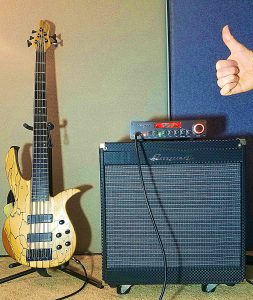
You’ve heard it before; you’re walkin’ the sidewalk somewhere, maybe downtown, and a car goes by that has the music up so high you know their ear cilia is getting as fried like KFC chickens.
Interestingly though, the only thing you can hear is that big, low rumble of the bass frequencies rolling past and through you, and bouncing off all the buildings all around.
The power of those deep frequencies. Pretty impressive.
If you want to learn how to play a bass guitar, you’ve probably already felt that power, and wanted to feel what a high it is to play low. I feel you.
I began playing the bass lines to all my songs early on and I wouldn’t have it any other way. I often bring in guests to play on my material, but not on the bass. There’s just something veeeeery special about that frequency range…
Sticky Bass Fingers
Along with the drummer, you are the glue that keeps a song chuggin’; you’re the foundation upon which is built the most impactful songs ever written and produced.
So the first thing you should do before you even pick up the instrument is this: start training your ear to hone in on the bass and the drum sounds on any song you hear. Listen to how they work together. The kick drum and the snare are the two biggies for the bass to complement, so especially zoom in on the interplay between those three.
You can be listening for these things anywhere, anytime there’s music on. Start the habit now. It’ll come in handy when you start practicing, and it’ll make you a better musician because instead of focusing on your fingers all the time you’ll be listening to what you’re playing, and how it gels with the rest of the musicians.
Blow Your Mind with String Theory
Since you’re interested in playing a bass guitar, I’m going to assume you have one (if not, SEE THESE BEST BUYS ON BASSES and get one), and I shall assume it’s a normal four-stringed model. There are many other variations but let’s stick with what’s simple to begin.
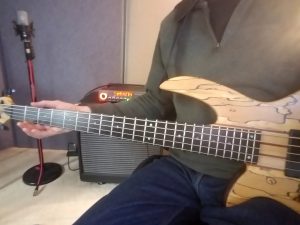
Sit down and set your bass on your legs, ready to play. The neck and headstock should be pointing off to your left.
If you’re left-handed, it’s the opposite, but in that case you should have a specially made left-handed bass.
Look down at the four strings of your bass. The one closest to your head is the lowest string. Some might be tempted to call it the “highest string” since it’s the one closest to the ceiling. When naming our strings, we don’t go by ceiling proximity; we go by the notes of the instrument.
Play the lowest string. Now play the three others. Do you hear how the notes are getting higher the closer you get to the floor? Did you notice as you played higher that the strings grew thinner? The thinner the string, the higher the pitches.
I will now give you the notes of the open (non-fretted) bass strings, lowest to highest (closest to your head, to farthest from your head). They are:
E
A
D
G
These are the notes you will hear if you are not touching the neck at all, not pushing down any notes (called “fretting”). You must memorize what these open strings are. Do it now. Keep reminding yourself every day until you can recall it perfectly and instantly.
If you need a funny acronym to remember them, try these:
E very
A ardvark
D igs
G rubs
Or, if you’re not a zoologist:
E mpires
A lways
D ie
G rudgingly
Or, if you’re not into history:
E njoy
A ll
D ream
G ear
Or finally, if you’re a songwriter who loves his gear like me:
E very
A rtist
D evelopes
G. A. S.!!
Now go ahead and play all four open strings, low to high, and then high to low. Say the letter names as you play them.
If you do that every day for 5 minutes, for two weeks, I bet you you’ll never have to do it again. We humans are very predictable; if we repeat something over and over, we get really good at it.
Which is why I don’t practice turtle juggling. :-p
Make That Chromatic Automatic
Your next big step, to get you really playing easily as soon as possible, is to memorize the Chromatic Scale. What’s that? It’s every note that we use in music! Don’t worry – there aren’t that many; only twelve tones comprise our whole music system. Easy-peasy. Here’s the outline:

Couple of things to notice:
- There are only TWO places where there are no sharps (#) or flats (b), and that’s between E & F, and B & C. Every other place you will remember to put in the flats and sharps.
- Once you get up to the note that shares the same letter name as the note you started on, it just repeats, higher and higher. This is how it is on the piano keys you see, and it’s also true for your bass, as it is for every Western instrument. There isn’t just one A, or B, or C, etc. There are many. They repeat as you go up or down.
- There are only seven natural notes with no flats or sharps.
To make it easy, let’s start with “A”. It is the first letter of our alphabet, after all. With that in mind, let’s state the Chromatic Scale out loud. Like this:
- A
- A sharp, or B flat
- B
- C
- C sharp, or B flat
- D
- D sharp, or B flat
- E
- F
- F sharp, or B flat
- G
- G sharp, or B flat
- A…
As you can see, when we get to “A” again, it starts all over. Get it?
When you know this, and ongoingly practice it on your bass, you will be able to find any note on your bass quickly and easily. Why is this important? Music is made up of chords, and if you ever play with others they’ll tell you what chords they are playing by name (like “B”) and you’ll have to match that.
If you don’t know where “B” is, you’ll be lost. And they’ll notice. And they might not call you again. So let’s not let that be our story.
Practice speaking the Chromatic Scale out loud a lot, until you know it so well you can’t possibly make a mistake. You can do this anywhere, anytime.
You’ll also need to practice with your instrument. Here’s how:
- Pick one of your open strings.
- Say its name out loud.
- Put your finger on that same string, on the first fret. Say that next note name.
- Put your finger on that same string, on the second fret. Say that next note name.
- Put your finger on that same string, on the third fret. Say that next note name.
- Continue this until you reach the 12th fret. Most basses have two dots on the fret there. The name of this note will be the name of the note you started on. You now have played through all 12 notes and are starting to repeat!
If, for example, I choose to play my D string, I would play it open and say “D”. Then I would finger the first fret, play it, and say “D sharp, or E flat”. Continue this way up the neck, following the map of the scale above, and you are ROCKIN’, my friend!!
Quick note: when fretting a note, place your finger between the frets (metal lines on the fretboard). If you put your finger on the metal you won’t get good tone at all.
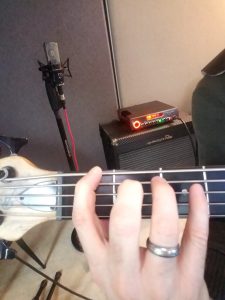
Remember, the more time you spend doing this, the quicker it will become easy. We all want easy, so just put in the time and you’ll soon be able to keep up with other musicians and get to even more fun stuff a lot faster.
Now let’s look at how this applies to chords of real songs on the stream site right now!
Tonic – the Root of All Jammin’!
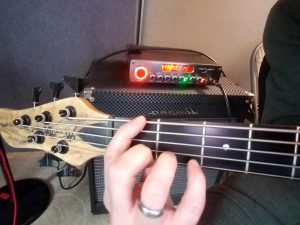
Each note that you play can be the “tonic“, or the “root” note of a chord.
If the chords of a song start with “F” (which is what I’m playing in the picture to the left), and you fret the note “F“, you will always sound correct!
The root is the most important note, and it’s easy to play because it’s the same letter as the chord name. Love it when things are that easy!
Now go to some site like http://www.guitarchords247.com, or if there’s music books lying around, open them up, find songs and play the root notes that match the chords you see for that song.
I’ve had days doing HOURS of this, and it taught me so much about songs, technique, ear training… the works! Try to play the whole song through, because as a musician you’ll have to play whole songs, not parts.
Plead the Fifth
Now we’ll get tricky! Heh, heh!
Whenever you’re on a chord, playing a root note, you can almost always throw in the “fifth”. Where do you find the fifth? Up two frets, and over one string. Here’s me playing a root note (F) and its fifth.
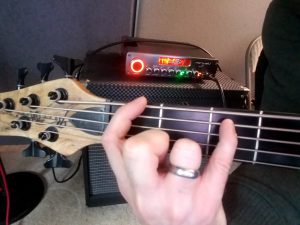
I know songs where the bass player plays fifths incessently. They are VEEEEEEERY commonplace, so get to know fifths as soon as possible. Just toss it in where it rhythmically fits with the groove of the song.
The Octave – Familiar Stranger
Hey! Haven’t I seen this note before?! Well, yes, you have. It’s the same note as the tonic note.
An octave is a note by the same name further up or further down musically. This next extremely popular note to throw in is just the root note, but higher. Let’s see how we fret the octave above our root note:
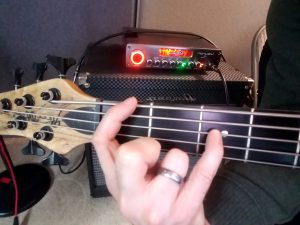
Now you are really empowered. Why? Because on almost any chord you read from now on, you have three different notes to play with that will be correct to play.
How will this help? Well, the biggest reason is it will make your playing a lot less boring. Imagine if all you did was pluck on the root note for seconds (or, God forbid, minutes!) on end. That get’s old pretty quick. Having these three options in your arsenal for any given chord will keep you harmonically interesting and rhythmically experimenting, which means no boring music!
Rollin’ in the Deep… BASS!
Adele must be a bass guitar fan, ‘cuz, man… that’s what we do best!
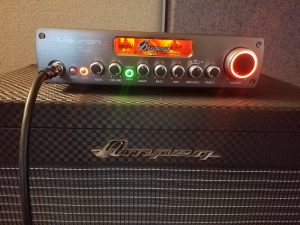
Lastly, you’ll probably have more excitement during your practice times if you actually plug into an amp.
I plugged my Bass Mods bass into my Bugera “Veyron” amp head and Ampeg 15″ cab for this lesson.
You’ll be able to hear a lot clearer how things sound through an amp, plus you can listen for sloppiness and eliminate it much easier when you’re amplified. Play clean, or don’t play at all! 😉
If you practice what I’ve given you here, and apply yourself to the mental tasks as well as the physical, you will be having SO much fun SO soon… and that’s what it’s about.
Never let music be boring. It’s a wonderful gift and most everybody can do it if the right steps are taken.
Got questions? Lemme know in the comments. I’d love to hear from ya! Until then, you know what I’ll be doing:
“Rollin’ in the deeeeee – eeee – eeeep. Playin’ on my baaaa – aaaa – aaass… !
Now, go… make… sounds!
Teaj

Absolutely, John. Great to hear you want to jump into the electricity!
To answer your question, tell me: what country are you in? Also, you don’t have an amp either, right?
Hello there! I’m actually interested on playing bass guitar. My cousins and I play different instruments such as piano, electric guitar, drums and more. We want to make a band and we need a bass guitar player. I’m down to do it but I don’t have a bass guitar yet. Do you have any suggestions that are good bass guitar for beginners? My price range is around $100-$250. By the way I like your guide on how to play a bass guitar. Thank you for sharing this and I really appreciate your response.